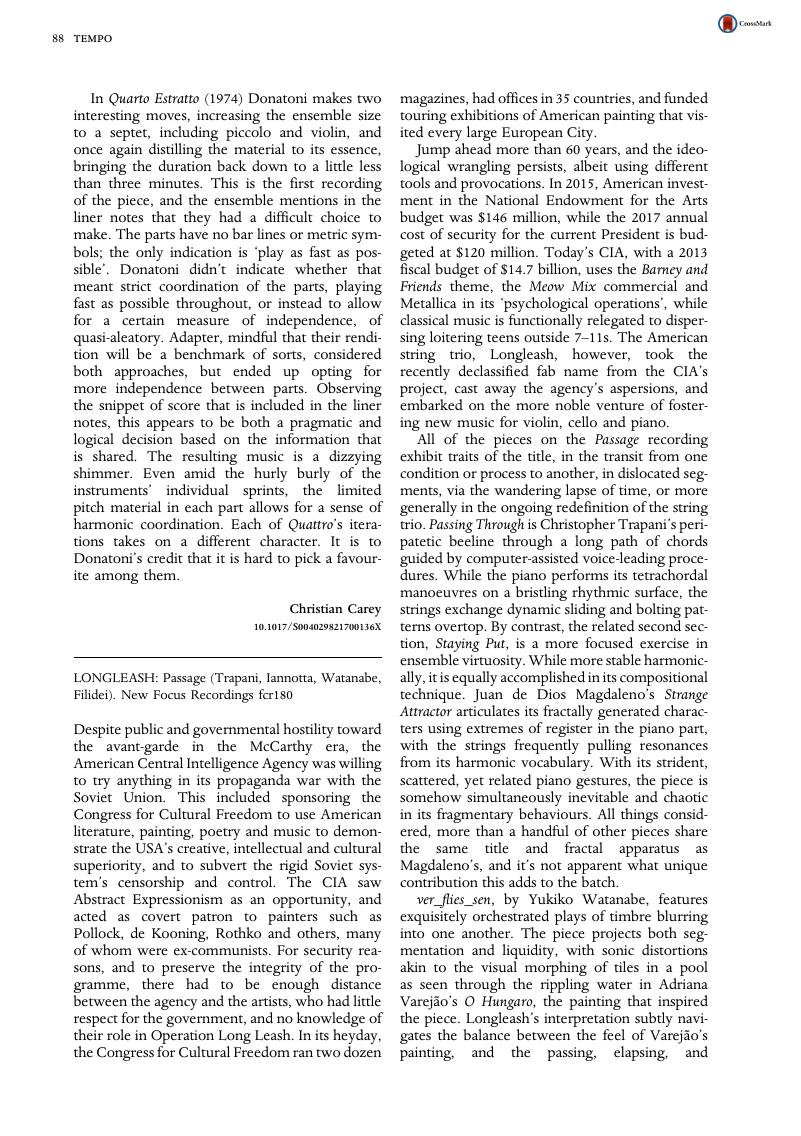Despite public and governmental hostility toward the avant-garde in the McCarthy era, the American Central Intelligence Agency was willing to try anything in its propaganda war with the Soviet Union. This included sponsoring the Congress for Cultural Freedom to use American literature, painting, poetry and music to demonstrate the USA's creative, intellectual and cultural superiority, and to subvert the rigid Soviet system's censorship and control. The CIA saw Abstract Expressionism as an opportunity, and acted as covert patron to painters such as Pollock, de Kooning, Rothko and others, many of whom were ex-communists. For security reasons, and to preserve the integrity of the programme, there had to be enough distance between the agency and the artists, who had little respect for the government, and no knowledge of their role in Operation Long Leash. In its heyday, the Congress for Cultural Freedom ran two dozen magazines, had offices in 35 countries, and funded touring exhibitions of American painting that visited every large European City.
Jump ahead more than 60 years, and the ideological wrangling persists, albeit using different tools and provocations. In 2015, American investment in the National Endowment for the Arts budget was $146 million, while the 2017 annual cost of security for the current President is budgeted at $120 million. Today's CIA, with a 2013 fiscal budget of $14.7 billion, uses the Barney and Friends theme, the Meow Mix commercial and Metallica in its ‘psychological operations’, while classical music is functionally relegated to dispersing loitering teens outside 7–11s. The American string trio, Longleash, however, took the recently declassified fab name from the CIA's project, cast away the agency's aspersions, and embarked on the more noble venture of fostering new music for violin, cello and piano.
All of the pieces on the Passage recording exhibit traits of the title, in the transit from one condition or process to another, in dislocated segments, via the wandering lapse of time, or more generally in the ongoing redefinition of the string trio. Passing Through is Christopher Trapani's peripatetic beeline through a long path of chords guided by computer-assisted voice-leading procedures. While the piano performs its tetrachordal manoeuvres on a bristling rhythmic surface, the strings exchange dynamic sliding and bolting patterns overtop. By contrast, the related second section, Staying Put, is a more focused exercise in ensemble virtuosity. While more stable harmonically, it is equally accomplished in its compositional technique. Juan de Dios Magdaleno's Strange Attractor articulates its fractally generated characters using extremes of register in the piano part, with the strings frequently pulling resonances from its harmonic vocabulary. With its strident, scattered, yet related piano gestures, the piece is somehow simultaneously inevitable and chaotic in its fragmentary behaviours. All things considered, more than a handful of other pieces share the same title and fractal apparatus as Magdaleno's, and it's not apparent what unique contribution this adds to the batch.
ver_flies_sen, by Yukiko Watanabe, features exquisitely orchestrated plays of timbre blurring into one another. The piece projects both segmentation and liquidity, with sonic distortions akin to the visual morphing of tiles in a pool as seen through the rippling water in Adriana Varejão's O Hungaro, the painting that inspired the piece. Longleash's interpretation subtly navigates the balance between the feel of Varejão's painting, and the passing, elapsing, and fracturing reflected in Watanabe's German title. Francesco Filidei's Corde Vuote (Open Strings) differs from the other pieces on the recording in its concentration on the violin and cello (the piano enters for the first time halfway through the piece), and its more constrained approach to materials and development. The placid flow of the work, along with the ringing sustains of the open strings and harmonics, appears to animate and anthropomorphize the strings into a set of gently respirating lungs. Notwithstanding its consistency, the piece also contains several deftly handled harmonic twists, particularly two-thirds of the way through, prior to its gradual, semi-retrograde exhalation.
Where the strength of Filidei's piece rests in his effortless and restrained application of open string spectra, in Il colore dell'ombra, Clara Iannotta delves further into spectrality via colour theory. Iannotta's powerful work can partially be heard through the filter of French impressionist painters, who adopted Eugène Chevreul's research into separating effects of light, and chiaroscuro. From Chevreul, Renoir gleaned that ‘No shadow is black. It always has a colour. Nature knows only colours’. Subsequently, shadow colour was no longer considered primary tone plus darkness, but a fine composite of pigments and their opposites. Similarly, Monet's 20 paintings of the Rouen Cathedral (1892–94) investigate the fleeting, changing light, colour and shadow on the structure at different times of day, different times of year, and in different weather conditions. Music, on the other hand, has the advantage of uninterrupted mobility through time, which is fundamental to Il colore dell'ombra’s achievement. In the first section, ‘Passage com un velo’, the loosened strings offer a dark, guttural quality to the transitory tone colourings of the cello, supported by the radiant cyclic rumbling of low piano harmonics. ‘D'un fiato’ (in one breath) continues the muscular deployment of extreme registers from the first movement, receding to calm, whistling harmonics in the strings. The brief final movement shimmies along like shifting colour filters, crossing, accumulating, and separating back in a mysterious continuity that quickly accelerates to its conclusion.
Overlooking the awkward, under-edited liner notes, Passage is an inspired debut album, on which Longleash is tethered to tight playing and bound together in lucid interpretations of the music.



